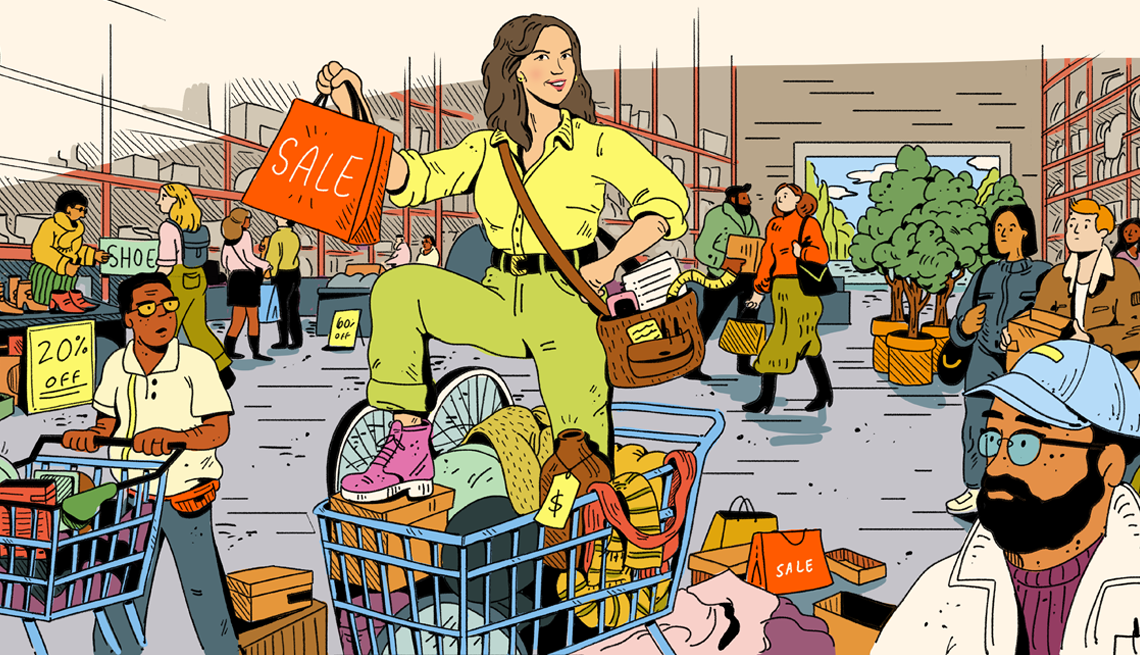AARP Hearing Center


Inflation fears sent me on a journey earlier this year. I took bargain hunting to the extreme, traveling hundreds of miles in search of new and surprising places where I could stretch my dollar to the max.
What I found amazed me.
I explored corners of the bargainverse that I had never experienced and that most people I know have never heard of. As a seasoned consumer journalist, I thought I had seen and shopped it all. I hadn’t!
My quest spanned six types of retailers, which I chose using three criteria: One, they needed to have physical locations in multiple states — and not just in New York, New Jersey and Connecticut, where I shopped with my husband, Bill — so no one-offs or online-only operators. Two, they had to offer deals you won’t find at your local discount chain or on Temu or TikTok. Three, they had to offer a variety of products and cater to a range of budgets.
At a time when many of us are looking for ways to save, I hope my travelogue inspires you to expand your own bargain-hunting horizons.
1. Bin stores
My shopping adventure began in a dimly lit warehouse off a small residential street in Bethel, Connecticut. It’s easy to miss; the only evidence of a giant store inside is a tiny sign on the door that says “Kathalow Warehouse Treasures.” Inside, stacks of home furnishings, electronics, small appliances, bedding and other merchandise fill shelves and clutter floors, and mountains of clothing, shoes and linens rise from long tables.
Like other stores in this category, Kathalow buys liquidated stock by the pallet rack. The industry is fueled in part by online returns, which are sold as “open-box” merchandise. The owner, Neda Macol, told me she also gets overstock and past-season products from Target, Kohl’s, Bloomingdale’s, Macy’s and other retailers. Some items were damaged, dusty or looking used, but I found a lot of great deals. A wood cabinet, for example, cost $79, 47 percent less than it did on Amazon; a gold wall sconce listed on Wayfair for $175 was only $39, a 78 percent discount. I also saw lots of clothing at flea-market prices, like children’s items for $3 apiece.
Unlike big closeout chains like Ollie’s, the vibe at smaller operators like Kathalow is chaotic, with varying levels of grunge. Many of these resellers are known as “bin stores” because they dump merchandise — clothes, electronics, bedding, beauty products and more — into giant, shallow bins. Every item in the bin has the same price, which may drop over time. At Mystery Bins in West Nyack, New York, for example, you’ll pay $15 per item on Saturdays, when new shipments arrive; prices drop daily until the following Friday, when the leftovers go for a buck. The store also sells individually priced large and small appliances.
I also took a road trip to Retail 101, a stadium-size warehouse in Shelton, Connecticut, that specializes in fashion and furniture. On a Thursday afternoon, the parking lot was packed, and customers were using enormous wheeled bins as shopping carts. I bought a $13 fanny pack that was $56 on the brand’s website. I also fell in love with a 10-foot-long teak dining room table in perfect condition, which I saw online for $2,900 but at this store cost only $600.
How to find them: Search online for closeout and bin stores or local liquidators. Try sites like thebinfinder.com and binstorefinder.com.
Special tips: Check items carefully and ask permission to open boxes; smaller operators are no-returns zones. Don’t expect warranties or, for larger items, delivery and installation services. And read reviews on Google and Yelp for insider insight; each store has its quirks
2. Thrift outlets
There are thrift shops, and then there are thrift outlets. Before this journey, I was well acquainted with Goodwill and similar shops, but I was totally unprepared for the outlet version. In Hamden, Connecticut, it was a quiet Monday afternoon in February, but inside the town’s Goodwill thrift outlet, it was pandemonium. Hordes of shoppers were ransacking boat-size bins of clothing, books, shoes, home goods and electronics, and tossing their finds into overloaded shopping carts.
This is where Goodwill dumps its overflow. Bins of donations are rolled out continually. Almost everything is priced by the pound — glassware and dishes are 69 cents a pound, and other stuff is $1.79 per pound. The charity says that a shirt costing $7 at a Goodwill thrift store may cost as little as 50 cents at a Goodwill outlet. My favorite part was the furniture. Although most of it needed some work — a deep clean, small repair or paint job — tables, cabinets and couches were priced at just $5 or $10.




































































You Might Also Like
99 Great Ways to Save Money and Beyond
Celebrate saving with new and exclusive tipsGreat Ways to Be a Better Online Shopper
Compare prices, hunt for digital coupons and use these other tactics before clicking “buy”
My Daughter Spends Way Too Much Money
Encouraging better spending habits with tact and respect